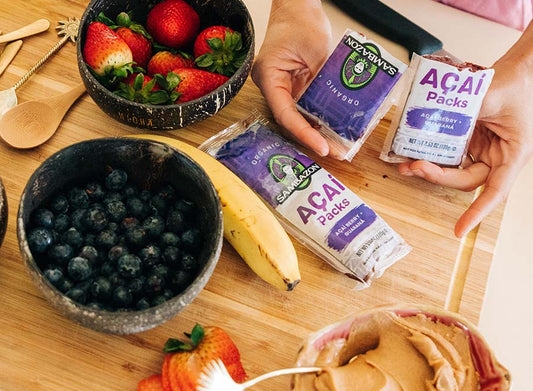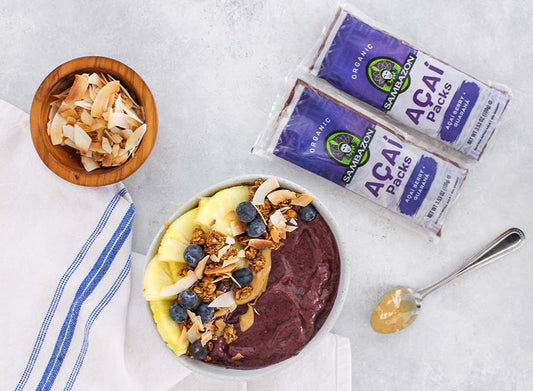20 years ago, when someone said “Açaí,” you might have said, “No idea what you’re talking about!” SAMBAZON started importing Açaí into the USA in 2000 after its founders discovered the incredible Amazonian fruit on a surf trip to Brazil. Since then its popularity has exploded, and chances are, you’ve experienced Açaí in a bowl, smoothie, bite, or dessert (maybe even on a daily basis!).
But how much do you actually know about Açaí beyond the fact that it tastes delicious? Because this little purple wonder holds a world of surprises and we think you should know about them. Here are our top 5 Açaí facts.

1. Açaí grows on palm trees
We kid you not: Açaí is actually a palm fruit. It grows on the Açaí Palm (Euterpe Oleracea) which is native to Brazil and northern South American countries. The Açaí Palm grows in the floodplains of the Amazon rainforest and as one of the most abundant trees in the region, it is tall and slender, growing nearly 90 feet (25+ meters) tall with pinnate leaves up to 10 feet (three meters) long. The trees themselves have multiple trunks and are used mostly for fruit, hearts of palm, and building materials.

2. Açaí can go rancid if not frozen
People often ask us why they can’t just buy Açaí berries in the store and why it has to be frozen. There’s actually a very good reason for that...because of the levels of healthy omega fats found in the Açaí fruit, if it’s not frozen after being freshly picked, will start to turn rancid. We pick and freeze our acai within 72 hours of harvest All SAMBAZOZN Açaí is flash-pasteurized. Flash-pasteurization guarantees that SAMBAZON Açai is safe for all while preserving taste and nutrition value. What’s more, we carry out continuous and exhaustive laboratory testing to make sure SAMBAZON's processing techniques achieve negligible nutrient and flavor losses while guaranteeing full food safety. The flash pasteurized Açaí is then frozen and transported around the world!

3. Açaí is packed full of healthy omegas
Unlike any other “berries” you might be familiar with, Açaí naturally contains omegas 3,6, and 9. The overall fatty acid profile of Açaí is very similar to that of olive oil and Açaí is said to support heart health, brain function, and healthy skin and hair, all while providing sustaining energy. Can your blueberries say that?!

4. Açaí is one of the only fruits that doesn't contain sugar
Yes, you read that right! As much as we love our strawberries, blueberries, and raspberries over here, we keep an eye on how many we consume due to the sugar content (one cup of blueberries = 15 grams of sugar). Açaí on the other hand, is sugar-free in its natural state. Of course you can sweeten it with sugar, agave, or honey, but if you start with a pack of unsweetened Açai in your smoothie or bowl, the rest is up to you (and your sweet tooth!).

5. Açaí is high in antioxidants
That wonderfully deep purple color that gives away the fact you just chowed down on an Açaí bowl? That’s thanks to its anthocyanins content. Anthocyanins are a type of flavonoid -- a class of compounds with antioxidant properties (you might recognize them from red wine). As well as being free-radical busters (the job of antioxidants), anthocyanins may also offer anti-inflammatory benefits.
There’s so much more we could tell you about Açaí, but we figured these are pretty good thought-starters. Which one did you find the most surprising? We’d love to hear!








Comments
(0 Comments)Please note, comments need to be approved before they are published.